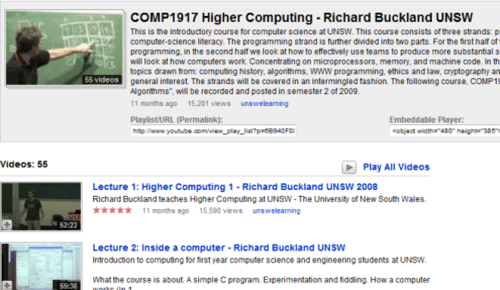A computer science professor at an Australian University is doing something revolutionary with YouTube – he’s offering students who can’t attend his classes college credit for watching his videos. Richard Buckland, a senior lecturer at the University of NSW in Sydney, Australia, was frustrated that high school students with a passion for computing and capable of studying at the college level were not able to make the commute to the university fit into their school day. Buckland then decided to turn YouTube into a remote classroom where the students could attend lectures virtually and then complete coursework just as his other students do.

Although several universities today use YouTube as a repository for lectures posted by college professors, they are generally offered as supplementary material for their enrolled students – the videos offer a handy way to go back and review previous classes. In addition, the public nature of those videos allows people from around the world to view the educational material that once took thousands, if not tens of thousands, of dollars to access.
Universities such as Duke, Stanford, MIT, and the University of California, among others, already post videos online both to YouTube and in iTunes U, a section of iTunes featuring audio and video podcasts. However, what UNSW is doing is unique – they’re providing college credit to those watching the YouTube recordings.
YouTube U
While there’s really little difference between physically showing up in a classroom to sit and listen to a lecture and viewing a video of the same lecture, few universities have allowed this type of unstructured remote learning to count as college credit for those who are not already enrolled in the university. Instead, colleges that support distance learning initiatives usually require students to apply for admission and pay tuition, just as any other student attending classes on campus would have to.
The fact that Buckland is not charging the high school students who are remotely attending his courses but is still giving them college credit is what makes what he’s doing so different…and perhaps groundbreaking.

The process of UNSW’s “YouTube education” is not entirely without structure, though. Only a limited number of high school students are chosen each year for this opportunity. Those who wish to attend must submit a statement as well as an academic reference from a teacher. In other words, receiving college credit for watching the videos isn’t something available to anyone, anywhere – there is still a selection process that is adhered to.
Higher Learning or Marketing Campaign?
Colleges who want to follow in UNSW’s footsteps could easily take this idea and turn it into a recruiting or marketing campaign for their university. By offering high school students transferable college credits valid at their particular institution, they could encourage the brightest young students to consider their university over others long before it came time to fill out the admissions packet.
No matter what reason a college may have for pursuing this type of remote learning, giving students the chance to work ahead – and at no additional expense to them – is an idea that hopefully spreads to other institutions worldwide.










